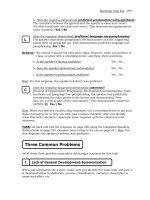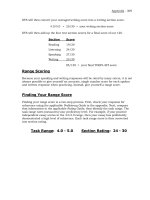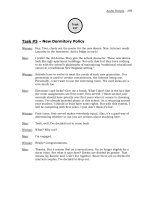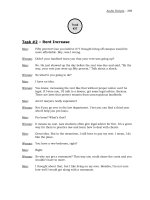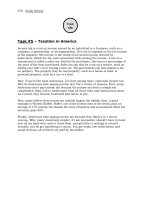Tài liệu Speaking and Writing Strategies for the TOEFL iBT part 29 doc
Bạn đang xem bản rút gọn của tài liệu. Xem và tải ngay bản đầy đủ của tài liệu tại đây (305.66 KB, 10 trang )
Speaking Task Five - 269
When taking notes, identify the context first. The context introduces the speakers
and the main topic. The problem will come right after the context.
context
problem
On your note map, summarize the context and the problem under Problem
context
problem
The two solutions will come right after the description of the problem.
Student: Professor Morrison?
Professor: Hi, Sue. Come in. What’s up?
Student: I just wanted to remind you of the meeting tonight
in Anderson Hall.
Professor: Meeting? What meeting?
Student: The Environmental Club meeting. You said you’d
come and give us talk about winning the National
Science Prize.
Professor: Tonight? Oh, no. I promised the Biology Club I’d
speak to them tonight in Farnell Hall.
Student: I see. But we’re expecting a big crowd. We’ve been
advertising it all month. We even sold tickets to
raise money. I guess I’ll just have to refund them.
P S
student reminds professor G
about talking to the
environmental club 1
professor forgot about 2
meeting; he will talk to
biology club instead C
Remember!
270 - Speaking Task Five
solution #1
solution #2
Next, summarize each solution under Solutions on your note map.
One solution = one body paragraph. Also, each body paragraph will
contain a cause-and-effect relationship. The cause-and-effect
relationship is the reason why this suggestion is a possible solution.
Professor: Look, maybe we can work something out. You
know, I could always record my talk to the Biology
Club, then email you the file. That way you could
present my talk to your group at your convenience.
Student: That would work. Yeah.
Professor: Also, I’m part of a lecture tomorrow night over at
Gethin-Jones Hall. The topic is ethics and nano
engineering. You have to buy tickets. But since I’m
speaking, I’m sure I can get you and your group in
free. I’d be willing to stay after and answer
questions about the prize. That way I can still keep
my promise. What do you think?
P S
student reminds professor G
about talking to the
environmental club
however professor forgot 1 first professor could record his talk
meeting; he will talk to to bio club then email it to student
biology club instead student could present professor’s
recorded talk to her club
at her convenience
2 second professor is part of a lecture
tomorrow night; he can get student
free tickets and talk to her club after
about his prize
that way he can keep promise
C those are the solutions to the problem.
Remember!
Speaking Task Five - 271
After you listen to the dialogue, the prompt will appear on your screen. The
narrator will read the prompt.
When the narrator stops speaking, the countdown clock will start (20, 19, 18…).
You will have 20 seconds to prepare your response.
On your note map, identify which solution you think is best. Because you will have
no time to write out your position, look at the Solutions
side of your note map and
circle the solution you think is best.
Prompt The professor and the student discuss solutions to
the problem. Identify the problem, then state which
solution you think is best and why.
Read the prompt.
Step #3
S O
G G record talk
Ti first professor could record his talk 1
to bio club then email it to student
C student could present professor’s
recorded talk to her club at her 2
convenience
Ti second professor is part of a lecture C best option
tomorrow night; he can get student
free tickets and talk to her club after
about his prize
C that way he can keep promise
C those are the solutions to the problem.
Speak (60 seconds).
Step #4
272 - Speaking Task Five
When the countdown clock reaches zero, you will hear a “Beep!” Look at your note
map. Start speaking. You will have 60 seconds. Start by summarizing the context
and the problem.
When summarizing the context and the problem, speak objectively
using third person and the present tense.
Next, identify and summarize the two solutions. Continue to speak objectively.
Next, state your personal-opinion argument using G+TiC=C. When you state your
argument, identify and describe which solution you prefer and why.
When you deliver your argument, speak subjectively using the first
person and the present tense.
In the dialogue, a student from the Environmental Club
reminds her professor that he is supposed to talk to her club
about his prize. The student is expecting a big crowd.
However, there is a problem. The professor forgot about the
meeting and is talking to the Biology Club instead.
The professor offers two solutions to the student’s problem.
First, he suggests that he can record his talk to the Biology
Club, then email it to the Environmental Club. That way the
Environmental Club can watch his talk whenever they want.
Second, he suggests that the Environmental Club can see his
lecture tomorrow night. The professor offers free tickets and
says he will stay and talk to the club after about his prize. That
way he can keep his promise.
Those are the two solutions to the student’s problem.
Speak (60 seconds).
Step #5
Remember!
Remember!
Speaking Task Five - 273
Notice how this speaker has given two reasons to support his solution
preference.
If possible, use your own experience to support your solution
preference, for example:
Personally, I think that the professor should record his talk,
then email it to the Environmental Club.
By doing so, the Environmental Club can watch the recording
whenever they want.
Also, because the talk is recorded, the Environmental Club can
watch it many times.
For those reasons, recording the talk is definitely the best
solution.
Personally, I think that the professor should record his talk,
then email it to the Environmental Club.
By doing so, the Environmental Club can watch the recording
whenever they want. This is what I did when a professor of
mine missed some classes. To stay on schedule, the professor
recorded his lectures, then emailed them to all her students. It
was great because I could watch the lectures as much as I
wanted. By doing so, I got more out of them.
For those reasons, recording the talk is definitely the best
solution.
Remember!
274 - Speaking Task Five
Mapped out, you can see how G+2TiC=C and G+TiC=C give the speaking raters
what they are trained to listen for: a coherent integrated spoken response that
demonstrates OPDUL=C
. Note: Transitions (T) are in bold, the supporting
illustration (i) in italics, the general introduction-context and opinion (G) and the
conclusions (C) underlined
.
G = general = In the dialogue, a student from the Environmental
Club reminds her professor that he is supposed to
talk to her club about his prize. The student says she
is expecting a big crowd. However, there is a
problem. The professor forgot about the meeting and
is talking to the Biology Club instead.
general = The professor offers two solutions to the
student’s problem
.
TiC = specific = First, he suggests that he can record his talk to the
Biology Club, then email it to the Environmental Club.
That way the Environmental Club can watch his talk
whenever they want.
TiC = specific = Second, he suggests that the Environmental Club
can see his lecture tomorrow night. The professor
offers free tickets and says after he will stay and talk
to the club about his prize. That way he can keep his
promise.
C = general = Those are the two solutions to the student’s
problem.
G = general = Personally, I think that the professor should record
his talk, then email it to the Environmental Club.
TiC = specific = By doing so, the Environmental Club can watch the
recording whenever they want.
TiC = specific = Also, because the talk is recorded, the
Environmental Club can watch it many times.
C = general = For those reasons, recording the talk is definitely
best solution.
Keep your eye on the clock. For this task, there is a lot of information
to squeeze into 60 seconds.
Warning!!
Speaking Task Five - 275
Using G+2TiC=C and G+TiC=C, and speaking at a normal pace, you should be able
to deliver a response that demonstrates OPDUL=C
in 60 seconds. The following
map illustrates approximate time divisions for each step of this task.
You are reading the example. On test day, you will pause and hesitate
when you speak and thus use more time.
G 10 seconds In the dialogue, a student from the
Environmental Club reminds her professor that
he is supposed to talk to her club about his
prize. The student says she is expecting a big
crowd. However, there is a problem. The
professor completely forgot about the meeting
and is talking to the Biology Club instead.
30 seconds The professor offers two solutions to the
student’s problem.
TiC First, he suggests that he can record his talk to
the Biology Club, then email it to the
Environmental Club. That way the
Environmental Club can watch his talk
whenever they want.
TiC Second, he suggests that the Environmental
Club can see his lecture tomorrow night. The
professor offers free tickets and says he will stay
and talk to the club after about his prize. That
way he can keep his promise.
C Those are the two solutions to the student’s
problem.
G 20 seconds Personally, I think that the professor should
record his talk, then email it to the
Environmental Club.
TiC By doing so, the Environmental Club can watch
the recording whenever they want.
Also, because the talk is recorded, the
Environmental Club can watch it many times.
C For those reasons, recording the talk
is definitely the best solution.
How Long Should My Response Be?
Remember!
276 - Speaking Task Five
Check the sample response for Coherence using the proficiency checklist.
Does the response demonstrate organization?
The speaker uses deduction as a method of organizing his summary of the
problem and the solutions suggested. Also, the speaker uses deduction as
a method of organizing his opinion and the reasons for why he thinks the
recording solution is best. This demonstrates organization. Yes √ No _
Does the response demonstrate progression?
Because the speaker uses deduction for both the summary of the dialogue
and his opinion, both his objective summary and his subjective opinion
progress from general to specific. This demonstrates progression.
Yes
√ No _
a. Does the introduction demonstrate development-summarization?
The speaker has summarized the main points in the dialogue with no
points left out. Also, the speaker has stated his opinion regarding which
solution he thinks is best. The speaker’s opinion is arguable, supportable,
a complete sentence and not a question. This demonstrates introduction
development-summarization. Yes √ No _
b. Does the body demonstrate development-summarization?
The speaker has summarized the main points in the dialogue with no
points left out. Also, the speaker has developed his opinion with reasons
explaining why he thinks recording the talk is the best solution. This
demonstrates development-summarization. Yes
√ No _
c. Does the conclusion demonstrate development-summarization?
The speaker concludes the dialogue summary with a restatement of the
topic sentence. Also, in his argument, the speaker restates his opinion in
his conclusion for why recording is the best solution. This demonstrates
conclusion development-summarization. Yes
√ No _
a. Does the response demonstrate topical unity-synthesis?
The speaker demonstrates how the summary of the problem-solutions and
his argument are topically united. He does so by focusing on which
solution he thinks is best from the two suggested solutions in the dialogue
summary. Also, there are no topic digressions. This demonstrates topical
unity-synthesis. Yes
√ No _
b. Does the response demonstrate grammatical unity-synthesis?
The topic-sentence transition between the dialogue summary and the
speaker’s argument is correct. The transitions within both the dialogue
summary and the speaker’s argument are also correct. This demonstrates
grammatical unity-synthesis. Yes
√ No _
Does the response demonstrate proficient language use-paraphrasing?
The speaker objectively paraphrases the main points in the dialogue. There
are no errors in syntax or word choice. Also, the speaker summarizes the
O
P
D
U
L
Speaking Task Five - 277
dialogue using third person singular and the present tense, and states his
argument subjectively using the first person singular and the present
tense. This demonstrates proficient demonstrates language-use
paraphrasing. Yes
√ No _
Delivery: We cannot evaluate the next three steps. However, when you practice in
class, or alone with a recording device, ask these three questions.
a. Is the speaker’s fluency proficient? Yes _ No _
b. Does the speaker demonstrate automaticity? Yes _ No _
c. Is the speaker’s pronunciation proficient? Yes _ No _
Note: For this response, the speaker’s delivery was proficient.
Does the response (argument) demonstrate coherence?
Because of Organization, Progression, Development-summarization, Unity
synthesis and Language Use-paraphrasing, the speaker has proficiently
identified and summarized the problem in the dialogue and the solutions.
The speaker has also stated which solution is best and why. This
demonstrates coherence (OPDUL=C
). Yes √ No _
Note: When you practice constructing responses for this task, use a recording
device or get your class and instructor to help you with your OPDUL=C
revision
checklist. After you identify areas that lack coherence, repeat the same response
until the coherence level increases.
TASK: Go back and rate the response on page 273 using the Integrated Speaking
Rating Guide on page 324. Compare your rating to the one on page 341. Note
: For
this response, the speaker’s delivery was proficient.
What if you think the suggested solutions are not good enough? What if you have a
better solution? Can you state it? Yes. In this case, your solution is contrary to the
suggested solutions. This type of strategy is called a contrarian response. Look at
the following contrarian response.
Personally, I think that the professor’s solutions are not good
enough. The Environmental Club will be disappointed because
he did not bother to check his schedule. If students do not
check their schedules, they can get into a lot of trouble. The
best solution is for the professor to reschedule his talk with the
Environmental Club. By doing so, he will keep his promise and
set a good example.
C
Contrarian Response
278 - Speaking Task Five
In the previous sample response, the speaker is arguing against the suggested
solutions. More importantly, the speaker offers a new solution.
Make sure your contrarian solution is serious. Avoid this type of
response.
As you can see, the above response is not serious. The speaker is not arguing. The
speaker is simply complaining and FLAMING. Worse, the speaker does not offer a
solution to the problem. This will result in a lack of coherence (OPDUL=C
) and a
lower score.
Avoid these three problem areas when delivering a response for this task.
When you summarize the dialogue, make sure you accurately identify the context
and the problem.
A lack of context-problem development-summarization will result in a
lack of unity-synthesis (OPDU
L=C), specifically topical unity between
the dialogue and your argument stating which solution you think is
best. This will result in a lack of coherence (OPDUL=C
) and a lower
score.
When you summarize the dialogue, identify each supporting example (TiC). Each
example is a solution to the problem. Also, make sure you identify the cause-and-
effect relationship in each solution. The cause-and-effect relationships are the
reasons that support and develop each solution. This in turn, will help you develop
your argument in which you state which “solution you think is best.”
A lack of development-summarization, particularly of the two solutions
in the dialogue, is a big reason why test-takers score low on integrated
speaking task five.
I can’t believe the professor BROKE HIS PROMISE!!! That’s not
very nice. And he’s a professor?! Personally, I would have
absolutely no respect for him after that! If bought a ticket, I
would be VERY MAD!!!
Remember!
Three Common Problems
Lack of Context-Problem Development-Summarization
1.
Remember!
Lack of Body Paragraph Development-Summarization
2.
Remember!
